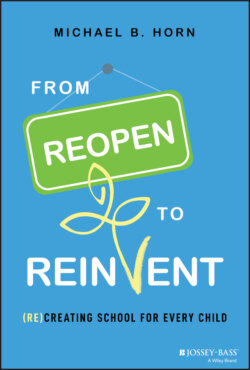Читать книгу From Reopen to Reinvent - Michael B. Horn - Страница 13
The Story of Jeremy and Julia
ОглавлениеJeremy and Julia are two of the 600 students at Spruce Park Elementary School in California.
As the bus rolled in to the school parking lot at 8:30 a.m., Jeremy trudged down the stairs and outside. He yawned.
After pausing for a moment, he noticed his fellow fifth-grade classmate Julia and a couple of her friends skipping up the hill to school. Walkers, he thought. A moment of envy flashed through his mind and then passed. He waved to Julia, who smiled and waved back.
Then his stomach grumbled. He turned to walk toward the school cafeteria to grab a quick bite before the bell rang. His mom had been so tired from working the late shift at the convenience store that she hadn't had time to scrounge some breakfast together. Again.
Jeremy couldn't sort through what was worse: when his mom was laid off when the pandemic started and she moped around the house all day while he was stuck inside away from his friends, school, and reliable food, or now when she had finally decided to work again and barely saw him—but at least he could see his friends at school and eat the cafeteria food. Maybe his teacher, Mrs. Alvarez, would ask him to write about it again. He sighed.
While Jeremy scarfed down food in the cafeteria, Julia happily skipped rope with her friends as they waited for the bell to ring. She loved these precious moments with her friends before they were told to sit silently during class and before the cascade of after-school activities that greeted her each day after dismissal. She loved gymnastics, piano, soccer, and robotics, but she sometimes longed for parts of the early days of the pandemic when the whole neighborhood was outside playing games of socially distant hopscotch under the California sun.
The principal, Dr. Kathleen Ball, watched all the students arrive—bussers and walkers alike. Her gaze was pleasant as she greeted each child by name. But her mind was elsewhere, as she wondered what was worse—the chaos and confusion of the early days of the pandemic or the tormented and unsettled nature of the current school year with so many students having so many different needs and so many parents frustrated that their child's needs still weren't being met.
Things were hard at the outset of COVID—so many decisions to make, so much uncertainty, so little time.
Ball had been so proud of how her teachers banded together and came up with creative solutions. They weren't perfect. But what they put together and the speed with which they did so was better than the alternative.
The parents were so kind, understanding, and appreciative back then. They understood the stress under which she and all her teachers were operating—even as they dealt with so much at home as well.
Things were different now. Different pockets of parents had different priorities and opinions. On everything.
That had always been true, of course. But now there was less trust. Needs had gone unmet and become more severe. Parents held higher expectations that these needs would be—no, should be—met. Many displayed a lack of common courtesy.
Now in the fourth school year impacted by the pandemic, her teachers and team just didn't have the same reserves to deal with the heightened expectations. They were all just exhausted—physically and mentally. They were overworked, and the school still struggled with staffing shortages.
Why couldn't parent emotions be focused on something else other than being angry at teachers, Ball wondered. If she were principal of a high school, maybe she could have at least rallied parent emotions around something else, like the opposing players on other schools' sports teams. She knew that sounded better only in theory compared to her current day-to-day reality.
